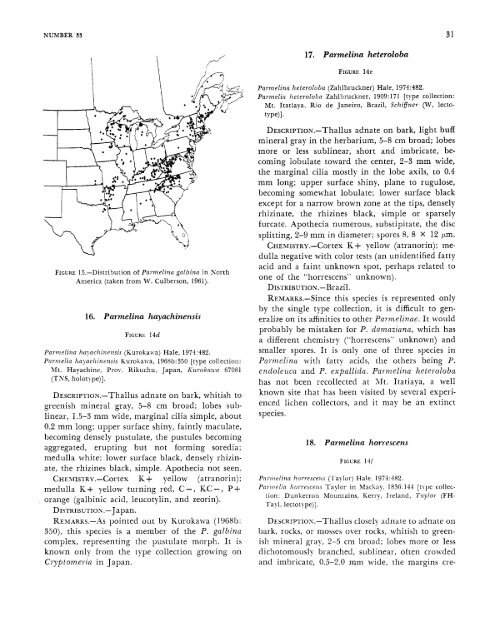A Monograph of the Lichen Genus Parmelina Hale - Smithsonian ...
A Monograph of the Lichen Genus Parmelina Hale - Smithsonian ...
A Monograph of the Lichen Genus Parmelina Hale - Smithsonian ...
You also want an ePaper? Increase the reach of your titles
YUMPU automatically turns print PDFs into web optimized ePapers that Google loves.
NUMBER 33 31<br />
FIGURE 15.-Distribution <strong>of</strong> Parrnelina galbina in Korth<br />
America (taken froin W. Culberson, 1961).<br />
16. <strong>Parmelina</strong> hayachinensis<br />
FIGURE 14d<br />
Parrnelina hayaclzinensis (Kurokait-a) <strong>Hale</strong>, 1971:482.<br />
Prrrnlelia ha)achinensis Kurokawa, 1968b:350 [type collection:<br />
hit. Hayachine, Proy. Rikuchu, Japan, Kurokawa 67081<br />
(TSS, holotype)].<br />
DEscRIPnoN.-Thallus adnate on bark, whitish to<br />
greenish mineral gray, 5-8 cm broad; lobes sub-<br />
linear, 1.5-3 mm wide, marginal cilia simple, about<br />
0.2 mm long; upper surface shiny, faintly maculate,<br />
becoming densely pustulate, <strong>the</strong> pustules becoming<br />
aggregated, erupting but not forming soredia;<br />
medulla white; lower surface black, densely rhizin-<br />
ate, <strong>the</strong> rhizines black, simple. Apo<strong>the</strong>cia not seen.<br />
CHE~IsTRY.-Cortex K + yellow (atranorin);<br />
medulla K+ yellow turning red, C-, KC-, P+<br />
orange (galbinic acid, leucotylin, and zeorin).<br />
DxsmIsuTIoN.-Japan.<br />
REMARKS.-AS pointed out by Kurokawa (1968b:<br />
350), this species is a member <strong>of</strong> <strong>the</strong> P. galbina<br />
complex, representing <strong>the</strong> pustulate morph. It is<br />
known only from <strong>the</strong> type collection growing on<br />
Cryptomeria in Japan.<br />
17. <strong>Parmelina</strong> heteroloba<br />
FIGURE 14e<br />
Parrnelina heteroloba (Zahlbruckner) <strong>Hale</strong>, 1974:482.<br />
Parrnelia heteroloba Zahlhruckner, 1909: 171 [tlpe collection:<br />
Mt. Itatiaya, Rio de Janeiro, Brazil, Schiflner (W, lecto-<br />
type)l.<br />
DEscRIPTIoN.-Thallus adnate on bark, light buff<br />
mineral gray in <strong>the</strong> herbarium, 5-8 cm broad; lobes<br />
more or less sublinear, short and imbricate, be-<br />
coming lobulate toward <strong>the</strong> center, 2-3 mm wide,<br />
<strong>the</strong> marginal cilia mostly in <strong>the</strong> lobe axils, to 0.4<br />
mm long; upper surface shiny, plane to rugulose,<br />
becoming somewhat lobulate; lower surface black<br />
except for a narrow brown zone at <strong>the</strong> tips, densely<br />
rhizinate, <strong>the</strong> rhizines black, simple or sparsely<br />
furcate. Apo<strong>the</strong>cia numerous, substipitate, <strong>the</strong> disc<br />
splitting, 2-9 mm in diameter; spores 8, 8 X 12 pm.<br />
CHEMIsTRY.-Cortex K + yellow (atranorin); me-<br />
dulla negative with color tests (an unidentified fatty<br />
acid and a faint unknown spot, perhaps related to<br />
one <strong>of</strong> <strong>the</strong> “horrescens” unknown).<br />
DIsmIsuTIoN.-Brazil.<br />
REMARKS.-siXICe this species is represented only<br />
by <strong>the</strong> single type collection, it is difficult to gen-<br />
eralize on its affinities to o<strong>the</strong>r <strong>Parmelina</strong>e. It would<br />
probably be mistaken for P. damaziana, which has<br />
a different chemistry (“horrescens” unknown) and<br />
smaller spores. It is only one <strong>of</strong> three species in<br />
Paimelina with fatty acids, <strong>the</strong> o<strong>the</strong>rs being P.<br />
endolezica and P. expallida. Parmelilza heteroloba<br />
has not been recollected at Alt. Itatiaya, a well<br />
known site that has been visited by several experi-<br />
enced lichen collectors, and it may be an extinct<br />
species.<br />
18. <strong>Parmelina</strong> horrescens<br />
FIGURE 14f<br />
Paririelina horresce?is (.laylor) <strong>Hale</strong>, 1974:482.<br />
Pnr,,relin korrescens Taylor in Mackay, 1836:144 [t!Iie collec-<br />
tion: Dunkerron Mountains, Kerry, Ireland, Taylor (FH-<br />
Tayl, lectotype)].<br />
Dk:scRrp?.xos.-Thallus closely adnate to adnate on<br />
bark, rocks, or mosses over rocks, whitish to green-<br />
ish mineral gray, 2-5 cm broad; lobes more or less<br />
dichotomously branched, sublinear, <strong>of</strong>ten crowded<br />
and imbricate, 0.5-2.0 mm wide, <strong>the</strong> margins cre-
















